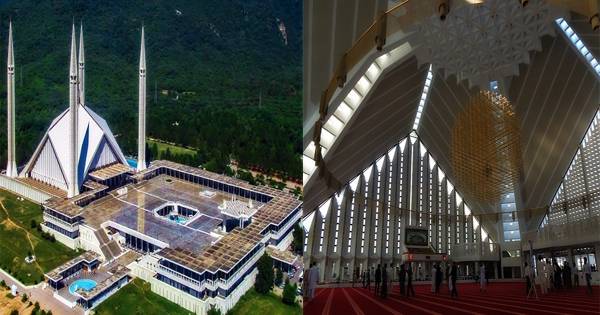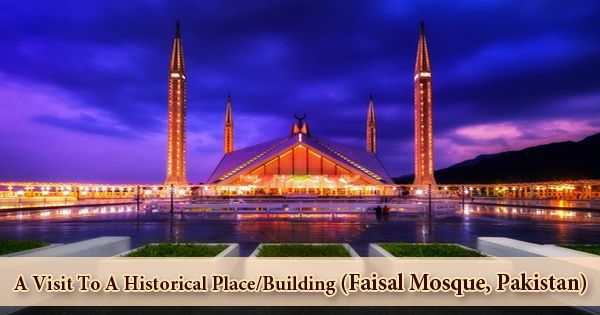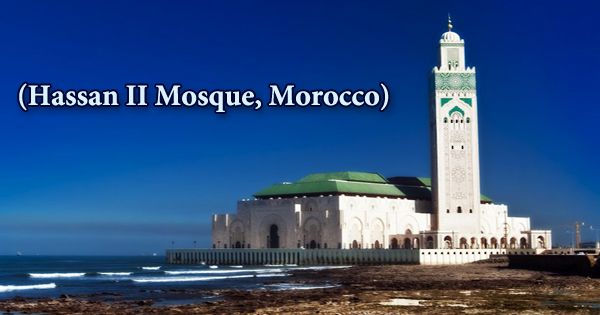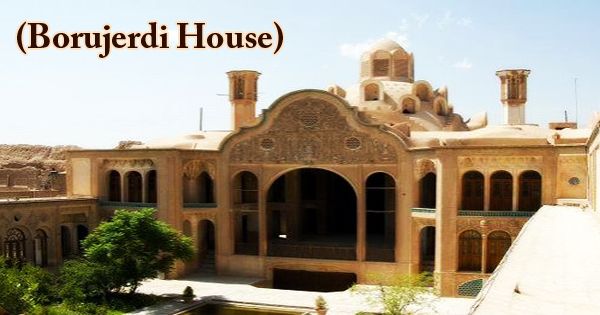The Faisal Mosque (Urdu: فیصل مسجد, romanized: faisal masjid) is situated at the end of Shaharah-e-Islamabad, against the backdrop of the picturesque Margalla Hills. It is a mosque in Pakistan’s Islamabad; it was the world’s largest mosque upon completion; it is currently the world’s fifth-largest mosque and South Asia’s largest. The mosque is inspired by a Bedouin tent and has a modern architecture consisting of eight sides of a concrete shell. The main prayer hall and courtyard, surmounted by sloping roofs (a stark contrast to the typical domes found in most mosques), is said to accommodate about 100,000 people. The mosque is a contemporary and popular piece of Islamic architecture and a major tourist attraction in Pakistan. This placement determines its meaning, ensuring its visibility for miles around during day and night by placing it on the elevated terraced ground. The mosque is dedicated to the memory of the late King Faisal of Saudi Arabia, who, as a gift to the people of Pakistan, graciously paid the cost of the project. After an international competition, the unorthodox design by Turkish architect Vedat Dalokay was chosen. The mosque is built like a Bedouin tent without a traditional roof, surrounded by four minarets that are 260 feet (79 m) high. The four 88-m minarets (an old urban myth is that they were examined by the ever-paranoid CIA, thinking they were rockets in disguise!) tower over the hall of prayer. Within, with muffled recitations, the ceiling soars to 40m, and the breeze hums. The late President’s mausoleum, Zia ul-Haq, is adjacent to the mosque. In combination, the building occupies an area of 54,000 square feet and dominates the Islamabad landscape. It is located at the northern end of Faisal Road, at the northernmost end of the city, and at the foot of the Himalayas’ westernmost foothills, the Margalla Hills.

The mosque was conceptualized as the national mosque of the newly founded Islamic nation at its inception and was supposed to symbolize Pakistan’s hopes and aspirations. The combined building occupies an area of 33 acres (130,000 m2; 1,400,000 sq ft), and the Islamabad landscape is dominated by the mosque. In terms of size, Faisal Mosque is now the fourth largest mosque. It is a major tourist attraction and Islamic architecture is considered a contemporary and influential feature. Around 300,000 worshippers can be housed in the Faisal Mosque. Each of the four minarets of the Mosque is 79 m (259 ft) high (the tallest minarets in South Asia) and has a diameter of 10 × 10 meters. Instead of conventional domes commonly associated with mosques, an eight-faceted concrete shell symbolic of a desert tent is the main prayer hall. The shell reaches a height of 131′- 3 ” (40m) and is supported by four massive concrete girders, an incredible engineering feat. The surface is covered with white marble and adorned with mosaics and a stunning Turkish style chandelier inside. The hall will hold 10,000 worshippers. The entrance is from the east, where a courtyard with porticoes faces the prayer hall. Beneath the main courtyard, the International Islamic University was located but has now moved to a new campus. A library, lecture hall, museum, and cafe are all located in the mosque. Four high minarets measuring 300 ‘- 0’ (90m) flank the mosque. Inspired by Turkish architecture, the minarets are slender and pointed, the shape and abstraction derived from a square base shaped by the intersection of two planes. The interior of the main tent-shaped hall is paved in white marble and decorated by the famous Pakistani artist Sadequain with mosaics and calligraphy, and a stunning Turkish-style chandelier. The pattern of the mosaic adorns the west wall and has the Kalimah written in early Kufic script, replicated in the pattern of the mirror image. Visitors are welcome, but non-Muslims are asked to avoid Fridays and times of prayer.
















